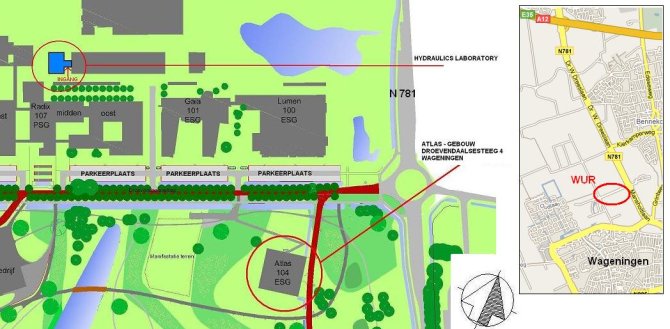
Facility
Kraijenhoff van de Leur Laboratory for Water and Sediment Dynamics
The experimental research of the Laboratory for Water and Sediment Dynamics mainly focuses on morphological responses to channel flow and overland flow. Current research topics are in the fields of stream restoration, gully erosion, side channels created by longitudinal dams and bedform dynamics.
Facilities

Straight Flume
The straight flume has an effective length of 13.6 m and an internal width of 2.6 m and features a sediment catch, which can be connected to the sediment pump for recirculation of sediment.
| Total lenght | 18.0 m |
| Test reach length | 12.8 m |
| Width | 2.6 m |
| Depth | 0.7 m |
| Inclination | 0 |
| Maximum discharge | 190 l/s |
| Discharge sediment pump | 4 l/s |
| Resolution bed scanner | 1 mm2 |
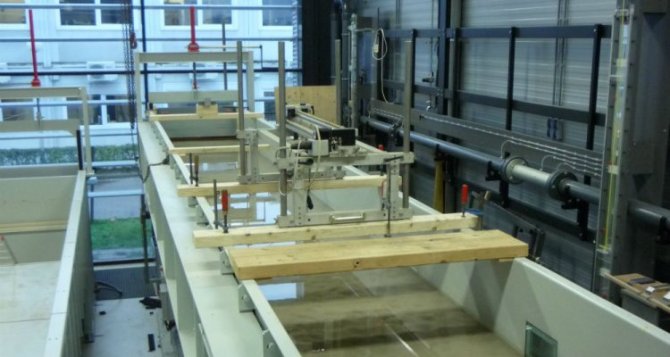
Tilting flume
The tilting flume is a 1.2 m wide tilting flume, with an effective length of 14.4 m. The flume has sediment catch at the downstream end, and a sediment pump for recirculation of bed material.
| Total length | 17.1 m |
| Test reach length | 14.4 m |
| Width | 1.2 m |
| Depth | 0.5 m |
| Maximum inclination | 4% |
| Maximum discharde | 190 l/s |
| Discharge sediment pump | 4 l/s |
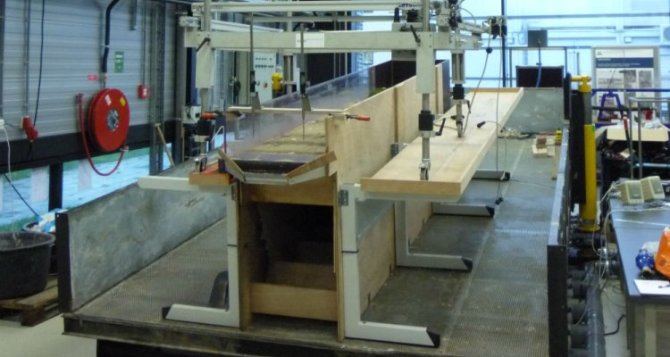
Rainfall simulator
To test the impact of a raindrop on a soil surface and test the vulnerability of a soil type to overland flow and erosion, a rainfall simulator has been installed with different rainfall intensities.
| Test reach length | 6.0 m |
| Width | 2.5 m |
| Depth | 0.6 m |
| Maximum inclination | 15 degrees |
| Height nozzles | 3.0 m |
Teaching facilities
Closed conduits model
Two types of energy losses in closed conduits can be studied in this model:
- friction losses (caused by friction at the inner wall of the conduit) and;
- local losses (caused by sudden changes in the conduit).
Small demonstration flume
This 2.5 m long and 0.08 m wide flume provides students with the ability to study fluid flow phenomenon associated with weirs and sluice gates. Sediment can also be applied to the bed to demonstrate bedform dynamics and sediment transport. The flow system is entirely self-contained and the flume is portable meaning it can be move into any suitable laboratory or class environment for use.
Large demonstration flume
This 5 m long and 0.3 m wide flume allows students to study a wide range of topics including the hydraulics associated with different types of weir and sluice gate. Bed roughness and channel slope can also be adjusted and the apparatus includes a closed sediment circuit which allows a sand sediment load to be fed into the flow enabling bedload transport rates and phenomenon such as local scour around bridge piers to be investigated.
Venturi meter and orifice
Measuring discharges in closed conduits is possible with an orifice or Venturi meter. Students learn how these widely used systems are working by applying the energy conservation law and the equation for continuity of mass.
Physical scale model of a training dam
Physical scale model with a mobile bed composed of lightweight sediment to establish morphodynamic behaviour around a training dam (River Rhine - The Netherlands).
To manage the expected extremity in high and low river discharge, the state authority for infrastructure Rijkswaterstaat in the Netherlands, is searching for an alternative river design. Currently, the banks on both sides of the River Rhine are protected by groynes. Besides bank protection, the groynes keep the cross-section of the river relative narrow, to ensure water depth for navigation. During high water, however, the groynes are flooded and cause an increase in hydraulic roughness and because of this an increase in water level.
A possibility to ensure the navigation depth during low flow, and reduce the water levels during a high discharges, is the replacement of the groynes by a training dam at the inner bend of the river (Figure 1). The training dam will be placed at 30 meter from the head of the removed groynes and parallel to the river bank. Only at the shallow inner bend there is space for a new construction without reducing the width of the fairway. Between the training dam and the bank a new channels is created. The flow into this side channel is regulated by a fixed weir, so only a limited discharge will flow through the side channel during a low flow situation. During a flood the large amount of water can discharge trough the side channel, because extra space is created since the groynes are removed.
An uncertainty in the new dam and weir design is the behaviour of the river bed morphology during low and high flow. To adequately test the unknown morphological effects at local scale (dam size scale) a physical scale model is built in a flume (Figure 2). The scale model captures both the bed levels around the intake point of the side channel and the effect of the bed levels in the navigation channel. The model has a mobile bed composed of light weighted polystyrene to simulated the bed load transport in the channel. The relative density of the material in water is 1.055. In polystyrene dunes are developing in equal proportions to dunes in the prototype river. The applied flow velocity in the model is based on a scaling analysis of the dimensionless bed shear stress.
Laser scan results of the bed level shows that during low discharge the training dam has a positive effect on the bed levels in the navigation channel. The interpretation of the model results and the translation to the prototype is mainly focussing on the spatial pattern of erosion and sedimentation and the relative bed levels.

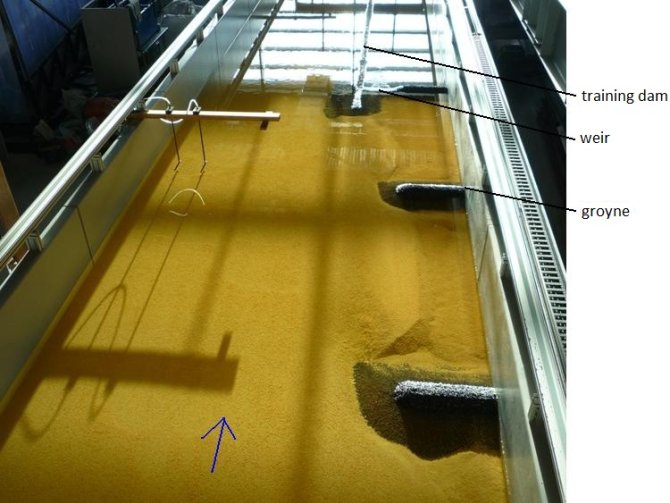
Impact of silt on bedforms and sediment transport
A flume model to test the influence had by silt concentration in sand-silt mixtures upon channel bedform geometry and sediment transport rates.
Subaqueous geometric bedform properties such as height, length and leeside angle are crucial in determining hydraulic form roughness and interpreting sedimentary records. Traditionally, bedform existence and geometry are predicted with phase diagrams and empirical equations, which are mostly based on uniform, cohesionless sediments. However, mixtures of sand, silt and clay are common in deltas, estuaries, and lowland rivers where bedforms are ubiquitous. Bedform dimensions may decrease when clay (<4μm) is present and when high suspended sediment concentrations (SSCs) suppress bedform growth. Non-cohesive silt (~30 - 63μm) is mainly transported in suspension and is therefore expected to limit bedform height and length. Weakly-cohesive silt (4-~30μm) is expected to limit bedform development similar to clay. Evidently, it is unknown what the exact influence is of silt on bedform dimensions.
In this flume model we tested the influence of silt in sand-silt mixtures on bedform geometry and sediment transport characteristics. The 15m tilting, recirculating flume in the Kraijenhoff van de Leur Laboratory was used for this analysis. Sand and silt content were systematically varied for various discharges and the resulting dynamic near-equilibrium bed geometry was measured with a line laser scanner (see Figure 1).
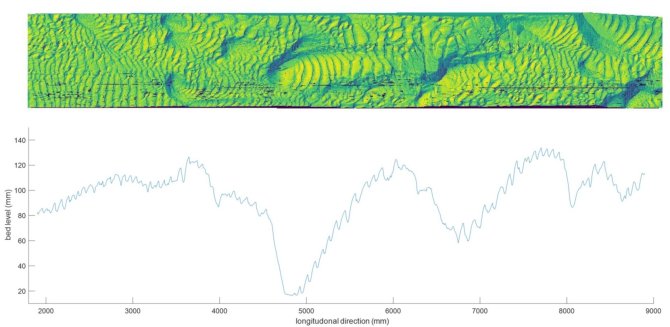
Water levels, 3D velocity profiles, suspended sediment concentration (SSC) and grainsize distributions were also recorded. The data collected will be used to seek relationships between bedform geometry and silt content in the riverbed, bed shear stress and SSC. It is hypothesised that with increasing silt concentration, SSC increases and the hydraulic roughness decreases, resulting in a decrease in bedform height and length. Figure 2 shows an example of the dune beforms generated during the experimental runs, prior to laser scanning.

Publications
-
Flow and bed morphology response to the introduction of large wood for sediment management
-
Scale‐dependent evanescence of river dunes during discharge extremes
Geophysical Research Letters (2020), Volume: 47, Issue: 6 - ISSN 0094-8276 -
Diversion of flow and sediment towards a side channel separated from a river by a longitudinal training dam
Water Resources Research (2020), Volume: 56, Issue: 6 - ISSN 0043-1397 -
Wood-induced backwater effects in lowland streams
River Research and Applications (2020), Volume: 36, Issue: 7 - ISSN 1535-1459 - p. 1171-1182. -
Flow and bed morphology response to the introduction of wood logs for sediment management
Advances in Water Resources (2019), Volume: 130 - ISSN 0309-1708 - p. 1-11. -
Flow and Suspended Sediment Division at Two Highly Asymmetric Bifurcations in a River Delta: Implications for Channel Stability
Journal of Geophysical Research: Earth Surface (2019), Volume: 124, Issue: 10 - ISSN 2169-9003 - p. 2358-2380. -
Bed morphodynamics at the intake of a side channel controlled by sill geometry
Advances in Water Resources (2019), Volume: 134 - ISSN 0309-1708 -
Spatial glyphosate and AMPA redistribution on the soil surface driven by sediment transport processes – A flume experiment
Environmental Pollution (2018), Volume: 234 - ISSN 0269-7491 - p. 1011-1020.
Education
Several courses, given by the chairgroups HWM and SLM from Wageningen University offers make use of the facilities from WSL. The lab also provides a practical space for both BSc and MSc students, to carry out experiments for their thesis.
Read more
Wageningen University offers, spread over multiple chair groups, a number of courses that use the facilities of the Kraijenhoff van de Leur Laboratory for Water and Sediment Dynamics.
Introduction to Hydraulics
This course is designed for students who need a basic knowledge about hydraulics as an introduction to application oriented courses such as the design of irrigation systems and hydraulic structures. By concentrating on a detailed explanation of the laws of conservation of mass, momentum and energy, the course aims at providing the student a clear understanding of steady water flow through conduits, rivers, canals and soils. The course uses a reader which is compatible with this set-up. In this text book, proofs, derivations, theory and worked examples are given in full, but using simple mathematical notation and an ample amount of clarifying text. The following topics are covered: hydrostatics, measurement of pressure, flow and discharge, flow through pipelines, uniform and non-uniform open channel flow and steady flow around hydraulic structures. The course provides basic knowledge of hydraulics and hydrometry for application in the fields of irrigation, river design, drainage, erosion, water conservation and flood protection.
Fluid Mechanics
The course focuses on the processes governing fluid flow of water as well as air and the associated dynamical forces and energy. The three most important conservation laws will be discussed: conservation of mass, conservation of momentum and conservation of energy. The subjects of vorticity and system rotation will be discussed in detail. The basic differences between water (incompressible) and air (semi-incompressible) and their consequences on the fluid flow characteristics will be discussed. The course will provide an elaborate introduction to kinematics, dimensional analysis, laminar flow, boundary layer theory and turbulence. By the end of the course, an overview of modelling approaches is offered.
River flow and morphology
The course deals with advanced topics of river flow and morphology, emphasizing hydrodynamics, sediment transport and morphodynamics in rivers and streams. It first covers the basics of one-dimensional channel flow by deriving the St. Venant equations, and presents solution methods. Simplifications to the St. Venant equations are introduced that lead to kinematic and diffusion wave approximations, being the bases for flood routing methods. Next, flow curvature and the associated secondary circulation in river bends are discussed, including the derivation of a set of governing equations. The course proceeds with bulk properties of sediment, further focusing on the foundations of bedload and suspended load sediment transport. Bedform dynamics in rivers are subsequently analysed with the main focus on alternative types of bedforms and the associated resistance to the flow. The final lectures address river morphological concepts and introduce one-dimensional analytical models simulating riverbed evolution, both theoretically and in computer exercises. A significant portion of time is dedicated to the analysis of flow, sediment transport and bedform dynamics in the Kraijenhoff van de Leur Laboratory for Water and Sediment Dynamics.
Environmental Hydraulics
The course provides basic knowledge of hydraulics for application in quantitative water management (e.g. design of rivers, flood protection measures and hydraulic structures). By concentrating on a detailed explanation of the laws of conservation of mass, momentum and energy, the course aims at providing the student a clear understanding of steady water flow through conduits, rivers and canals.
Land and Water Engineering
Land Degradation & Remediation
Land Degradation and Remediation (SLM-10306) is an introductory BSc course which provides a general overview on the topics of land degradation processes, their measurement, conservation strategies and sustainable intervention options. The course contains three parts: A) Recognizing and understanding land degradation B) Conservation and remediation options C) How approaches to solving land degradation issues works in reality?
Contact
Hydrology and Quantitative Water Measurement Group
Soil Physics and Land Management Group
Location
Google Maps
Click here for a link to the exact location of the WSL Lab on Google Maps.


